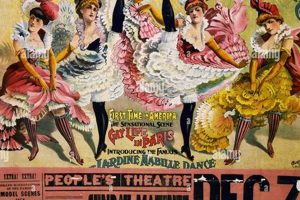These graphic artworks, often lithographs or screen prints, served as promotional material for musical performances and events. Created primarily from the 1920s through the 1960s, they showcased the burgeoning jazz scene and its iconic figures. An example might be a vibrant, Art Deco-style print advertising a performance by Duke Ellington at the Cotton Club.
These collectibles offer a unique window into the past, documenting the evolution of music and graphic design. They provide valuable insights into the cultural context of the era, reflecting social trends, artistic movements, and the burgeoning popularity of a distinct musical form. Their appeal lies not only in their aesthetic qualities but also in their historical significance and connection to pivotal moments in artistic and social history.
The following sections will delve into the key characteristics of these items, exploring their stylistic variations, notable artists, and factors influencing their value within the collector’s market. This exploration will provide a comprehensive understanding of their enduring appeal.
Collecting Considerations
Acquiring these artifacts requires careful consideration. Assessing condition, verifying authenticity, and understanding market values are crucial steps.
Tip 1: Examine Condition Meticulously: The physical state significantly impacts value. Look for tears, fading, stains, and evidence of restoration. A well-preserved piece commands a higher price.
Tip 2: Authenticate Provenance: Research the origin and history of the piece. Documentation, such as receipts or exhibition records, adds credibility and value.
Tip 3: Investigate Artist and Printer: Familiarize yourself with prominent artists and printing houses associated with these items. Work by renowned figures typically warrants a higher valuation.
Tip 4: Assess Rarity: Limited-edition prints or those associated with significant events are more desirable. Research print runs and event attendance to determine rarity.
Tip 5: Understand Style and Era: Recognize stylistic trends and their historical context. Art Deco, Swing Era, and Bebop-influenced designs each possess distinct characteristics affecting collectibility.
Tip 6: Consult Expert Opinions: Seek guidance from experienced dealers or appraisers. Their knowledge can help identify potential pitfalls and ensure informed decisions.
Tip 7: Consider Framing and Storage: Proper framing and archival storage are essential for preserving condition and protecting against environmental damage.
By carefully considering these factors, collectors can make informed decisions and build valuable collections.
The subsequent sections will explore specific artists and design styles, offering further insight into the realm of these historic items.
1. Historical Context
Understanding the historical context is paramount to appreciating these artworks fully. These posters are not merely decorative items but rather tangible artifacts that reflect significant socio-cultural and artistic movements.
- Prohibition Era Influence
The Prohibition era (1920-1933) created a clandestine environment that fostered the growth of jazz music in speakeasies and underground clubs. Posters from this period often reflect the rebellious and secretive nature of these establishments, using coded language and suggestive imagery to attract patrons. Example: A poster advertising a “private” performance featuring obscured faces and a tagline hinting at forbidden entertainment. The historical implication is a glimpse into a period of social upheaval and the music’s role as a form of resistance and expression.
- The Great Migration and Cultural Exchange
The Great Migration saw a mass movement of African Americans from the rural South to the urban North, bringing with them their musical traditions. These traditions subsequently fused with other genres, influencing the evolution of jazz. Posters from this era showcased African American performers and celebrated their cultural contributions. Example: A poster promoting a concert series featuring musicians from New Orleans performing in Chicago. The implication is the recognition of a significant demographic shift and its impact on the nation’s cultural landscape.
- World War II and the Swing Era
World War II impacted every facet of society, including the entertainment industry. Jazz became a symbol of American freedom and resilience, often performed for troops and featured in patriotic events. Posters from this period frequently incorporate nationalistic imagery and messages of unity. Example: A poster depicting a jazz band performing for soldiers, with the American flag prominently displayed. The implication is the integration of music into wartime morale efforts and its symbolic representation of national identity.
- The Civil Rights Movement and Social Commentary
As the Civil Rights Movement gained momentum, jazz artists began using their music as a platform for social commentary and protest. Posters from this era often reflected the struggle for racial equality and challenged societal norms. Example: A poster featuring a black musician with a clenched fist, promoting a benefit concert for civil rights organizations. The implication is the evolution of music as a tool for social activism and its engagement with pressing political issues.
By examining these posters through the lens of their historical context, collectors and enthusiasts can gain a deeper appreciation for their significance as cultural documents. Each poster tells a story, reflecting the complex interplay of social, political, and artistic forces that shaped the world of jazz.
2. Artistic Styles
The visual appeal and historical significance of vintage advertising art are intrinsically linked to the prevailing artistic styles of their respective eras. The graphic design choices made for these promotional pieces directly reflect and often amplified the aesthetic sensibilities of the time, contributing significantly to their collectibility and historical value.
- Art Deco Influence
This style, prominent during the 1920s and 1930s, is characterized by geometric shapes, bold colors, and streamlined designs. Examples include posters featuring stylized musicians, symmetrical compositions, and the use of metallic inks. The impact lies in conveying a sense of modernity, luxury, and the dynamism associated with early jazz culture. These posters often emphasized sophistication and the allure of urban nightlife.
- Mid-Century Modernism
Emerging in the post-World War II period, this style prioritized functionality, simplicity, and organic forms. Examples include posters with asymmetrical layouts, sans-serif typography, and the use of abstract imagery to evoke the mood of the music. The relevance stems from reflecting the era’s optimism and the growing popularity of jazz in suburban settings. These pieces often targeted a younger audience with a forward-looking aesthetic.
- Swiss Style (International Typographic Style)
Originating in Switzerland during the mid-20th century, this approach focuses on objectivity, clarity, and the use of grids to organize information. Examples are characterized by clean typography, sans-serif fonts, and photographic elements integrated with geometric shapes. Its impact is rooted in promoting a sense of order, precision, and professionalism, aligning with the evolving image of jazz as a serious art form. These advertisements communicated information in a clear, concise, and authoritative manner.
- Psychedelic Art
Emerging in the late 1960s, this style is characterized by vibrant colors, swirling patterns, and surreal imagery, often inspired by drug-induced experiences. Examples include posters with distorted typography, kaleidoscopic effects, and depictions of musicians in dreamlike settings. The significance stems from capturing the counter-cultural spirit of the time and the fusion of jazz with other musical genres. This imagery reflected a shift towards experimentation and a rejection of traditional norms.
These diverse artistic styles, when applied to advertisements, not only promoted musical performances but also served as visual records of evolving cultural trends. Collectors often seek pieces that exemplify specific stylistic movements, valuing them as representative examples of both musical and artistic history. The aesthetic choices made by designers provide invaluable insights into the cultural context of each era.
3. Promotional Purpose
These artworks existed primarily as marketing tools, integral to the dissemination and popularization of musical performances. The success of any given engagement, particularly in the competitive entertainment landscape of the time, depended heavily on the effectiveness of these visual advertisements. They served not merely as announcements but as carefully crafted invitations, designed to entice audiences and shape public perception. For example, a poster advertising a performance at a prominent venue, such as the Apollo Theater, functioned as a signifier of prestige and quality, associating the musician with a reputable brand and attracting a discerning audience. The financial viability of musicians and venues often hinged on the efficacy of these promotional campaigns.
Beyond driving ticket sales, these promotional pieces played a critical role in building and maintaining the public image of individual artists and musical genres. A poster showcasing a specific musician’s persona, through stylistic choices in design and imagery, directly contributed to shaping their brand and solidifying their presence within the cultural consciousness. The deliberate use of certain visual cues, such as specific fonts, colors, and artistic styles, worked to align a given performance with a desired demographic or to convey a particular atmosphere. The success of many iconic musicians, like Duke Ellington or Louis Armstrong, was partially attributable to the effectiveness of these strategic visual campaigns in cultivating a distinct and appealing public image. Furthermore, these posters provided crucial information about upcoming performances, including dates, times, locations, and ticket prices, facilitating access for interested attendees.
Understanding the promotional purpose provides critical insight into the context surrounding these artworks. By recognizing them not merely as aesthetic objects but as strategic marketing tools, one gains a deeper appreciation for their role in shaping the musical landscape. This understanding is invaluable for collectors, historians, and anyone interested in the intersection of art, commerce, and culture. The challenges in fully appreciating these posters lie in their limited availability and the difficulty in reconstructing the original marketing strategies. However, by combining archival research with an understanding of design principles and marketing techniques, a more complete picture of their significance emerges.
4. Iconic Musicians
The connection between iconic musicians and these artworks is fundamental to their appeal and historical value. These figures, through their talent and cultural impact, served as the primary subject and driving force behind these promotional items. The presence of a recognizable and celebrated musician on a poster directly increased its desirability and effectiveness as an advertising tool. For instance, a poster prominently featuring Charlie Parker performing at Birdland would instantly attract attention and generate interest due to Parker’s legendary status and association with a renowned venue. The musician’s image, name, and reputation became intrinsically linked to the artwork’s value and historical significance. Their popularity and musical achievements served as a key element in creating these memorable, collectible items.
Furthermore, the design choices made in these posters often reflected and reinforced the public persona of these figures. A poster featuring Louis Armstrong might utilize vibrant colors and energetic imagery to convey his jovial personality and exuberant performances, while a poster for Miles Davis might employ more subdued tones and abstract designs to reflect his introspective and innovative approach to music. These artistic choices were not arbitrary but rather deliberate attempts to capture the essence of each musician’s unique style and appeal. Consider a poster promoting Billie Holiday: the visual presentation would likely emphasize her emotional depth and captivating stage presence. The posters, therefore, served as extensions of the musicians’ identities and contributed to their lasting legacy. Understanding these factors is critical for collectors and enthusiasts in assessing value and appreciating the historical context of these promotional objects.
In essence, the iconic status of certain musicians is inextricably linked to the enduring popularity and value of these vintage posters. These artifacts serve as tangible reminders of their contributions to music history and reflect the ways in which their images were carefully crafted and disseminated to the public. The challenge lies in fully attributing the historical and cultural significance these figures bring to the value of each piece, given stylistic interpretation or the musicians current popularity. However, acknowledging the inherent connection between the musicians legacy and the poster’s imagery and design is crucial for appreciating their overall significance. The presence of an iconic figure is a key determinant of the value and collectibility, ensuring the visual artifacts remains a coveted item for those with an interest in music history and design.
5. Rarity Factors
Scarcity significantly influences the desirability and market value of promotional artworks. Several factors contribute to determining the uncommonness of these historical advertisements, transforming them into prized collectibles.
- Limited Print Runs
The original production volume directly impacts rarity. Posters printed in small quantities, often due to budgetary constraints or limited promotional campaigns, are inherently rarer than those produced in large numbers. Example: A poster advertising a one-night-only performance by a lesser-known artist at a small venue likely had a significantly smaller print run than a poster promoting a national tour by a major star. The implication is that surviving examples of the former are far more scarce and potentially more valuable.
- Geographic Distribution
The area of initial circulation affects current availability. Pieces circulated only within a specific city or region are less likely to have survived in significant numbers compared to those distributed nationally or internationally. Example: A poster promoting a local jazz festival held in a small town might have been confined to that immediate area, resulting in limited exposure and fewer surviving copies. The implication is that these geographically restricted posters are often highly sought after by collectors interested in regional music history.
- Survival Rate
The durability of the medium and the likelihood of preservation influence rarity. Posters printed on low-quality paper or displayed in harsh environments are less likely to have survived in good condition, further decreasing their availability. Example: Posters pasted on walls or lampposts, exposed to weather and vandalism, have a significantly lower survival rate than those stored flat in climate-controlled environments. The implication is that well-preserved examples, even of relatively common designs, command a premium due to their exceptional condition.
- Historical Significance of the Event
Posters associated with landmark performances, significant cultural events, or pivotal moments in a musician’s career tend to be rarer and more desirable. The event itself contributes to their collectibility. Example: A poster advertising a debut performance by a groundbreaking artist or a concert that marked a turning point in musical history carries additional historical weight, increasing its appeal to collectors and driving up its value. The implication is that the historical narrative woven into the poster plays a significant role in determining its rarity and worth.
In conclusion, the interplay of production volume, geographical reach, survival rates, and historical associations determines the scarcity of these vintage items. Recognizing and assessing these factors are essential for collectors and historians seeking to understand the market dynamics and historical importance of these cultural artifacts. The rarest pieces offer a unique glimpse into the past, providing valuable insights into the music, art, and culture of the era.
6. Collector Demand
The robust demand among collectors for graphic artworks directly impacts the valuation and preservation efforts surrounding these items. Collector interest functions as a primary driver, influencing market prices, authentication practices, and the overall awareness of these historical artifacts. An increase in demand invariably leads to a greater emphasis on identifying, cataloging, and safeguarding existing examples. Auction results, private sales, and the establishment of specialized collections serve as tangible indicators of the market’s dynamism and underscore the importance of collector interest in maintaining the value and visibility of these cultural assets.
Varied motivations underpin the demand within the collector community. Some collectors are drawn to the aesthetic qualities, appreciating the artistic styles and visual representations of musical culture. Others are motivated by historical significance, viewing these posters as valuable documents of a particular era. Still others may focus on specific artists, venues, or design movements, creating specialized collections that reflect their particular interests. For example, a collector specializing in posters from the bebop era might actively seek out examples featuring Charlie Parker or Dizzy Gillespie, contributing to increased prices for those specific items. This specialized interest further drives the market and elevates the status of the musicians and events depicted.
In conclusion, the interplay between these artistic items and collectors is fundamental to the continuing appreciation and preservation of these pieces of history. Collectors play a vital role in ensuring that these cultural artifacts are valued, studied, and protected for future generations. Fluctuations in collector interest can impact market trends, but the enduring appeal of music, combined with the inherent aesthetic qualities and historical significance of these advertisements, ensures their continued relevance within the collecting world. Challenges in maintaining interest may arise from changing tastes or economic conditions, but the establishment of stable collecting communities and the ongoing documentation and promotion of their significance can help to mitigate these risks.
7. Preservation Needs
The long-term survival of musical advertisement depends on specific preservation strategies. Given their age, materials, and inherent fragility, careful attention to these needs is critical for ensuring that these cultural artifacts endure for future generations. Failure to address these needs can result in irreversible damage and the loss of valuable historical and artistic resources.
- Environmental Control
Maintaining stable temperature and humidity levels is essential for preventing deterioration. Fluctuations can cause paper to become brittle, inks to fade, and adhesives to fail. For example, storing the visual artwork in a climate-controlled environment with consistent temperature and humidity minimizes the risk of damage. The implication is that proper environmental control significantly extends the lifespan and protects the structural integrity of these delicate items.
- Light Exposure Management
Prolonged exposure to light, both natural and artificial, can cause fading and discoloration of inks and paper. UV radiation is particularly damaging. Exhibiting pieces under UV-filtered glass or acrylic and limiting exposure to direct sunlight helps to mitigate this risk. The implication is that careful light management is critical for preserving the vibrancy and color fidelity of the artwork, ensuring that their visual impact remains intact.
- Acid-Free Materials
Using acid-free storage materials, such as archival paper, folders, and boxes, prevents acid migration and minimizes the risk of paper degradation. Acid migration from non-archival materials can cause yellowing, embrittlement, and eventual disintegration. The implication is that employing acid-free materials is fundamental to protecting the long-term stability and physical integrity of these vintage objects.
- Professional Handling and Storage
Proper handling techniques, such as wearing gloves and avoiding creases or folds, are essential for preventing physical damage. Storing posters flat in archival sleeves or folders protects them from dust, dirt, and accidental tears. The implication is that careful handling and storage practices are crucial for minimizing the risk of physical damage and preserving the structural integrity of these valuable assets.
Addressing these specific preservation needs is essential for ensuring the longevity and accessibility of these vintage advertisements. By implementing appropriate strategies, collectors, institutions, and enthusiasts can safeguard these cultural artifacts and ensure that their historical and artistic value is preserved for future generations. Investing in proper preservation methods is an investment in cultural heritage.
Frequently Asked Questions
The following addresses common inquiries regarding this form of visual advertisement, providing concise and informative answers to enhance understanding.
Question 1: What defines a “jazz vintage poster” as opposed to a more recent reproduction?
A verifiable vintage example originates from the period during which the performance or event it advertises occurred, typically pre-1970. Distinguishing characteristics include printing techniques and paper stock of the era, as well as signs of age consistent with authentic use.
Question 2: How does condition impact the value of graphic artwork?
Condition is a paramount factor. Examples in pristine condition, free from tears, fading, or significant damage, command substantially higher prices than those with imperfections.
Question 3: What are the key artistic styles encountered in visual advertisement, and how do they relate to the music?
Art Deco, Mid-Century Modern, and Swiss Style are prominent. These styles reflect the aesthetic sensibilities of their respective eras and often visually reinforce the musical genres cultural associations.
Question 4: How can the authenticity of graphic artwork be verified?
Authentication involves careful examination of printing techniques, paper stock, and signatures, as well as comparing the piece to known examples and consulting with experts in the field. Provenance documentation further supports authenticity.
Question 5: What factors contribute to the rarity of visual advertisement?
Rarity is determined by limited print runs, geographic distribution, survival rates, and the historical significance of the event advertised. Pieces associated with landmark performances or significant cultural events are typically rarer.
Question 6: What are the essential preservation methods for maintaining the long-term condition of visual advertisement?
Essential methods include environmental control (stable temperature and humidity), light exposure management (UV protection), use of acid-free materials, and careful handling and storage practices.
In summary, understanding authenticity, condition, artistic style, and preservation techniques is crucial for appreciating and managing these artifacts effectively.
The next section will delve deeper into resources for collectors and enthusiasts.
Conclusion
The examination of jazz vintage posters reveals their multifaceted significance. They stand as historical records of a vital musical era, showcase evolving graphic design aesthetics, and serve as tangible links to iconic performers and venues. Their rarity and condition, coupled with the nuances of collector demand, directly influence market value and necessitate careful preservation strategies.
The sustained appreciation of these artifacts ensures that the visual legacy of this art form remains accessible to future generations. Further research and careful stewardship are essential for preserving these tangible connections to a pivotal period in musical and cultural history, securing their place in the collective memory. The ongoing study and collection will provide future insights into the music and design during the jazz era.







